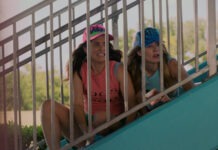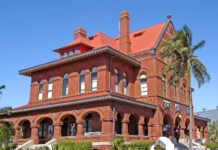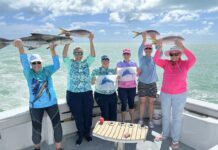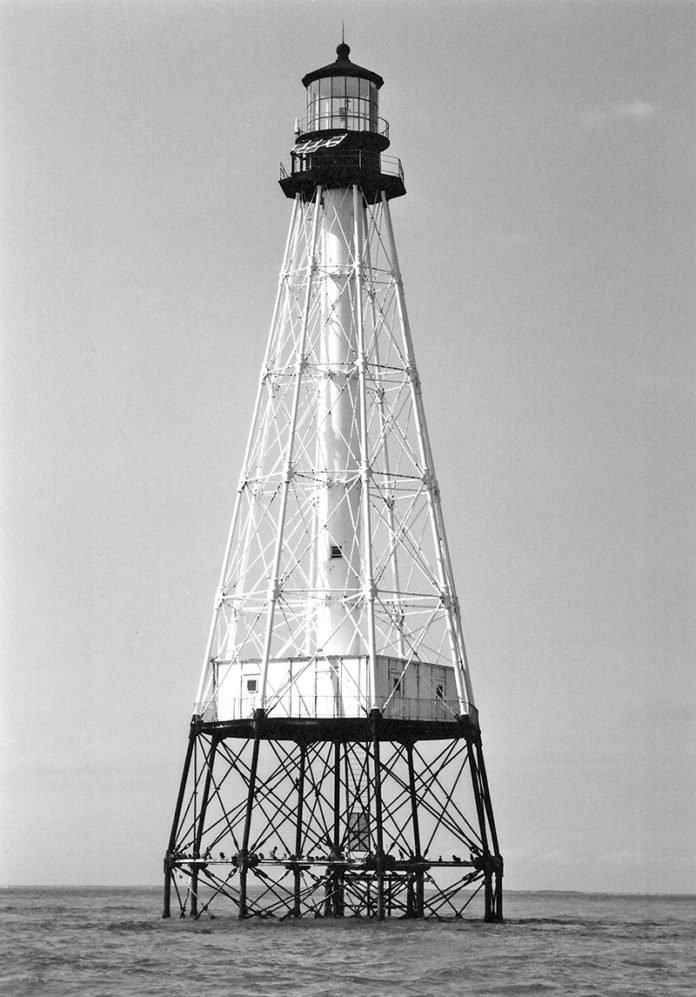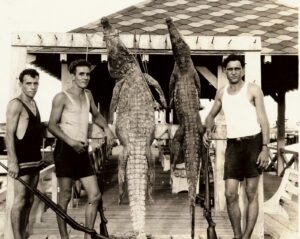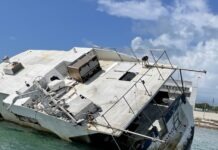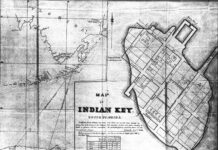The story reprinted in the Boston Globe on Nov. 22, 1896, originally appeared in the New York Sun. Jacob Bethel was visiting New York City from the Florida Keys, where he claimed to be a lighthouse keeper at Alligator Reef Lighthouse.
The stories Bethel told provide interesting glimpses into Alligator Reef Lighthouse and the lives of those tending its flashing light. Bethel is quoted as saying: “I see the red sectors are not so common up this way as they are with us. We’re a little ahead of the north in sectors, maybe because we need them more. They are the red streaks in the lantern, you know. Our light, for instance, has a radius of 20 ¾ miles. In some directions all is clear water, and in others there are dangerous reefs and shoals. The red glass is set in the lantern in such a way that when a mariner is sailing in dangerous water and looks up at the lantern he sees a red light. That is a delicate hint for him to change his course and get out. When he is sailing in clear water he sees nothing but a white light, and knows all is safe. All the principal lights on the Florida reefs have recently been fitted with these red sectors, and they are a great improvement.”
He also had some interesting comments about the change in lantern fuel being stored out at the lights. “I don’t know whether you’ve heard up this way that we are all in danger of having our heads blown off. It’s a fact, of course, you know the government has recently changed the character of oil we burn — put us to use mineral oils. We could store animal oil in the lighthouse safely enough, but such quantities of petroleum as we have to keep on hand put us in constant danger. We are very exposed to lightning, of course, and just suppose the lightning begins to meander among those 70 barrels of oil — what is going to become of Alligator light and its keepers?”
When the first lighthouses were erected along the reef, Carysfort Reef, Sand Key and Sombrero Key, whale oil was used to soak the light’s wick. Whale oil was derived from New England industries. By the mid-19th century, whale populations had decidedly decreased, and the U.S. Lighthouse Board began looking into alternative fuels. In an 1874 report to the U.S. Senate, the Lighthouse Board announced it would be switching to lard.
By 1877, the Lighthouse Board had switched to a cheaper form of fuel, kerosene. It would take time to convert the nation’s lighthouses to kerosene. As the stories reprinted in the Boston Globe appeared in 1896, the date of the original story published in the New York Sun is harder to pin down, but the fuel at Alligator Reef Lighthouse was switched to kerosene circa 1882.
The problem with Jacob Bethel’s stories about Alligator Reef Lighthouse is the storyteller. Several Bethels served at the lighthouses along the reef, including Joseph Bethel (1858-1859) and Theophilus I. Bethel (1878-1880). The only Jacob to serve at the lights marking the Florida Reef was a man named Jacob Rain, who was a second assistant keeper at Carysfort Reef Lighthouse for a brief time in 1860.
In 1896, Alligator Reef Lighthouse was staffed by head keeper Edgar J. Russell, first assistant William H. Curry, and second assistant keeper John Watkins for part of the year. He was replaced by George E. Billberry, who served until 1900. In the history of Alligator Reef Lighthouse, the only man named Bethel to have worked at the post was William A. Bethel, who served as a first assistant (1876-1878).
In 1870, William A. Bethel lived at nearby Indian Key with his parents William H. and Caroline. William did have a younger brother, James R. Bethel. Who then was Jacob Bethel? As it turns out, James is the English version of the Hebrew name Jacob and it appears that the man visiting New York and telling stories about Alligator Reef Lighthouse was William’s brother James who, apparently, went by the name Jacob. While his brother William has a rich history of lighthouse service in the Florida Keys, Jacob or James was a bit of a prankster and seemed to have been living vicariously through his brother while telling lighthouse stories to the New York reporter.

